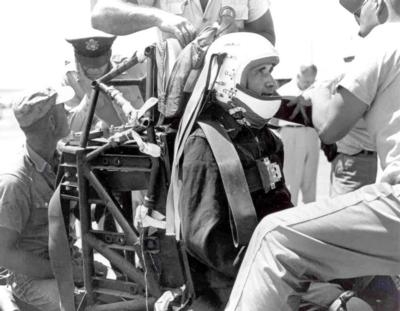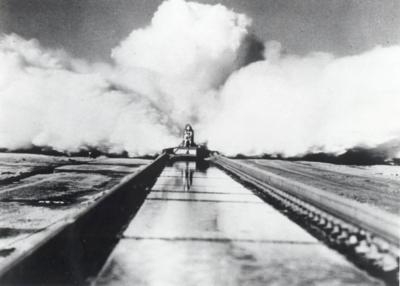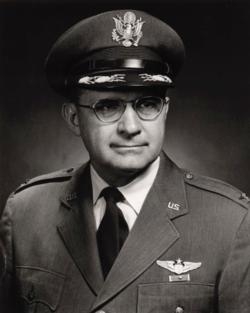Was Human Test Subject In Rocket Sled Experiments Proving High-Speed Ejection Was Survivable
On Dec. 10, 1954, Col. John P. Stapp propelled down the Holloman High Speed Test Track aboard the Sonic Wind Rocket Sled 1 at a rate of 632 miles per hour, earning the title, "The Fastest Man on Earth."

The rocket-propelled sled speed combined with the sudden 1.4 second stop, subjected Stapp to more than 40 times the pull of gravity, equivalent to hitting a brick wall at 50 miles per hour. The force Stapp withstood caused bruising, blisters and temporary blindness.
Stapp once said, "The effects of that run were relatively negligible, but the data obtained was invaluable."
The purpose of this experiment was to see at what speed a pilot could safely eject. He proved that a pilot flying at 35,000 feet, going twice the speed of sound, could withstand the wind blast if he or she had to eject. That sled run was the last human test at the Test Track. The sled that Stapp used for that test is now displayed at the New Mexico Museum of Space History. "Stapp's record-breaking sled run was the final manned-run in a series of windblast and deceleration tests designed to understand human tolerance to high-speed ejections from aircraft," said Kevin Rusnak, Air Force Research Laboratory historian. "Aside from the positive publicity the event garnered for the Air Force, it more importantly brought international recognition to Stapp's mission to improve the safety of Airmen and pilots."
Although Stapp had many volunteers for the test, he chose to do it himself because he did not want to subject anyone else to such a potentially dangerous situation. "I have the missionary spirit," Stapp said. "When asked to do something, I do it. I took my risks for information that will always be of benefit. Risks like that are worthwhile."
Stapp's research also brought on new safety measures people use today: seatbelts. By showing how much a person could withstand if properly restrained, Stapp became an advocate for seatbelts to be made in all cars. He was also involved in many experiments that used crash test dummies to see how force affects the human body. Stapp retired from the U.S. Air Force in 1970 as a Colonel.
In 1999, Col. John Stapp died in his home in Alamogordo, N.M. of natural causes.

December 10, 2014 marks the 60th anniversary of that record-breaking sled run, but Stapp's legacy will forever carry on at the Holloman High Speed Test Track. The track still conducts tests to include aircraft, environment, munitions, electronic combat and aerodynamics. Ejection seat tests make up approximately 14 percent of all tests done at the track. "The experiment opened up one of the major business areas that we focus on out here, and that's aircrew egress and aircrew safety during egress," said Jim Daniel, business development coordinator with the 846 Test Group.
Daniel said because of Stapp's experiment, the HHSTT is able to do experiments using aeromedical sleds and what they call manikins. The manikins are much like traditional crash-test dummies, but they are very advanced and include devices to measure vertical forces imposed by the ejection seat during a sled test.
"We want to make sure that all aircrew have a good chance of walking home after leaving the airplane behind," said Daniel.
The mission of the HHSTT is to plan and execute world-class rocket sled tests, enabling critical weapon system development in support of the warfighter. Thanks to Stapp's experiment 60 years ago, the HHSTT team is able to perform and continue to be the world's best rocket sled test team.
(USAF Images)
Ann Salutes Airman 1st Class Emily Kenney 49th Wing Public Affairs

 ANN's Daily Aero-Linx (04.15.24)
ANN's Daily Aero-Linx (04.15.24) Classic Aero-TV: 'No Other Options' -- The Israeli Air Force's Danny Shapira
Classic Aero-TV: 'No Other Options' -- The Israeli Air Force's Danny Shapira Aero-News: Quote of the Day (04.15.24)
Aero-News: Quote of the Day (04.15.24) Airborne 04.16.24: RV Update, Affordable Flying Expo, Diamond Lil
Airborne 04.16.24: RV Update, Affordable Flying Expo, Diamond Lil ANN's Daily Aero-Term (04.16.24): Chart Supplement US
ANN's Daily Aero-Term (04.16.24): Chart Supplement US





